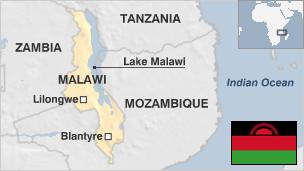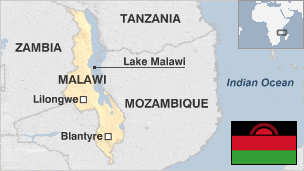-
16 June 2015
- From the section Africa

Malawi, a largely agricultural country, is making efforts to overcome decades of underdevelopment and the more recent impact of a growing HIV-Aids problem.
For the first 30 years of independence it was run by the authoritarian and quixotic President Hastings Kamuzu Banda, but democratic institutions have taken a firm hold since he relinquished power in the mid-1990s.
After President Banda lost the first democratic presidential election in 1994 his successor, Bakili Muluzi, established a far more open form of government.
Corruption, poverty and the high rate of HIV-Aids continued to hamper development and fostered discontent with the new authorities.
Most Malawians rely on subsistence farming, but the food supply situation is precarious and the country is prone to natural disasters of both extremes – from drought to heavy rainfalls – putting it in constant need of thousands of tonnes of food aid every year.
Malawi has been urged by world financial bodies to free up its economy, and has privatised many loss-making state-run corporations.
Since 2007 the country made real progress in achieving economic growth as part of programmes instituted by the government of President Bingu wa Mutharika in 2005.
Health care, education and environmental conditions have improved, and Malawi has started to move away from reliance on overseas aid.
Its single major natural resource, agricultural land is under severe pressure from rapid population growth, although the government’s programme of fertiliser subsidies has dramatically boosted output in recent years, making Malawi a net food exporter.
Tens of thousands of Malawians die of Aids every year. After years of silence, the authorities spoke out about the crisis. A programme to tackle HIV-Aids was launched in 2004, with President Muluzi revealing that his brother had died from the disease.


